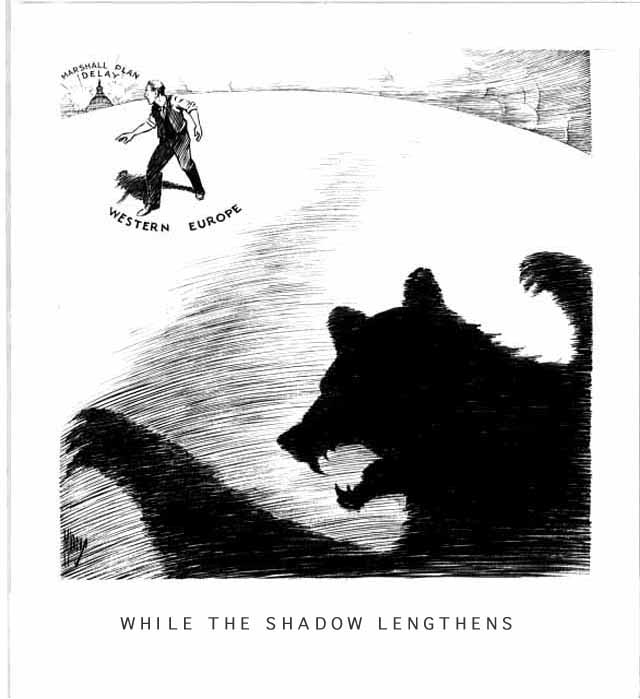UNIT 4: RESISTANCE TO LIBERALISM
| Site: | MoodleHUB.ca 🍁 |
| Course: | Social 30-1 RVS |
| Book: | UNIT 4: RESISTANCE TO LIBERALISM |
| Printed by: | Guest user |
| Date: | Monday, 3 November 2025, 4:31 PM |
Table of contents
- 1. OVERVIEW
- 2. Introduction
- 3. Characteristics of Totalitarianism
- 4. Emergence of Fascism
- 5. Life in Nazi Germany
- 6. QUIZ 4.1: NAZI GERMANY
- 7. The Holocaust
- 8. WWII
- 9. Emergence of Communism in Russia
- 10. Communism in the Soviet Union
- 11. Life in the Soviet Union
- 12. Propaganda
- 13. Conflicting Ideologies
- 14. The Cold War Begins
- 15. Expansionism and Containment
- 16. Alliances
- 17. Arms Race and Threat of Nuclear War
- 18. The Cuban Missile Crisis
- 19. Détente
- 20. Proxy Wars
- 21. The End of the Cold War
- 22. Ideological Conflict within Liberal Society
- 23. Aboriginal Perspectives and Liberalism
- 24. Liberalism and the Environment
- 25. Neoconservatism & Religous Perspectives
- 26. UNIT 4 SUMMARY
- 27. SUMMATIVE EXAM 2
1. OVERVIEW
Overview: Resistance to Liberalism

From its inception until today, liberalism was extended gradually to apply to all citizens in a nation. Working class people, new immigrants, and women obtained the right to vote. Governments began to provide positive liberties so that all people were free to pursue their own goals, regardless of their backgrounds, through the provision of education and social programs. Labour standards and labour unions developed to deal with the concerns of workers. Human rights were extended to all, including women, children, and members of minority groups.
However, at the same time that modern liberalism was developing in many parts of the world, other nations rejected the idea that liberal democracy could ever respond to some the problems that seemed to accompany liberal thought. Communism in the Soviet Union and other parts of the world reflected more collectivist values. Fascism in Germany rejected liberal principles in favour of greater government control and ultranationalism.
The conflict between ideologies influenced the political and economic structures which continues to influence today's world.
The last part of the unit focuses on how resistance to liberal principles occurs in Canada as well as in other parts of the world. Aboriginal groups, with their more collectivist worldview, reject some liberal principles. Religious groups and those who believe society needs to protect the environment also reject some fundamental beliefs of liberalism. In our world today, liberalism has been imposed on various nations against their will.
Take notes about reasons people and their governments reject liberalism and if the techniques they use are justified.
- Read the pages that follow.
- Study carefully all photos, artwork, propaganda posters, and historical film clips.
- Read the required textbook readings.
This unit has three sections:
- Why and how did Germany and Russia reject liberalism?
- How did conflict between ideologies shape our modern world?
- How does resistance to liberalism continue to influence the world today?
2. Introduction
Rejections of Liberalism Introduction
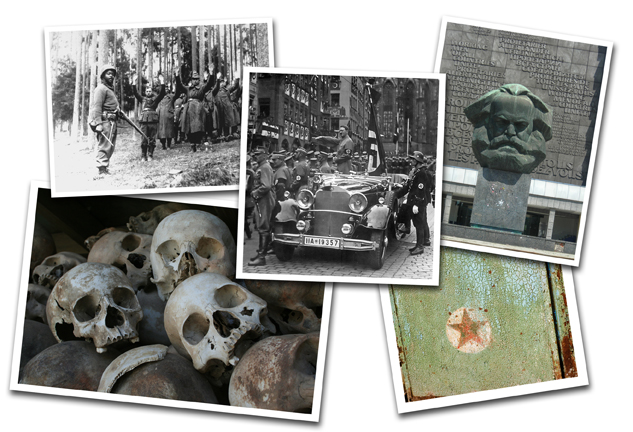
In Europe, the people of Russia had lived under authoritarian rule for centuries. Peasants were poor and had few rights. Although some democratic changes were implemented early in the 20th century, the people felt changes were coming too slowly. During World War I, a revolution led to the formation of a communist state (the Russian Revolution of 1917).
In contrast, Germany was an industrial power with a democratic government. Similar to most of Europe, the country was devastated by World War I. When the world's nations gathered to end the war, the victors decided Germany was entirely to blame and, therefore, must make reparations to the remainder of Europe. This, coupled with the global economic recession of the 1930s, led the people to despair. Eventually, they supported the fascist leader Adolf Hitler who promised them hope-and relief from payment of the reparations.
The ideologies of both the Soviet Union and Nazi Germany developed because the people believed the current way of doing things was hindering their possibilities of "the good life". They did not see any potential for a better life in a liberal democracy. The fundamental beliefs and values of the two ideologies were very different, but in both countries, a totalitarian regime resulted.
The ideologies of the Soviet Union and Nazi Germany were were very different, yet they were both founded on the discontent of citizens and their leaders.
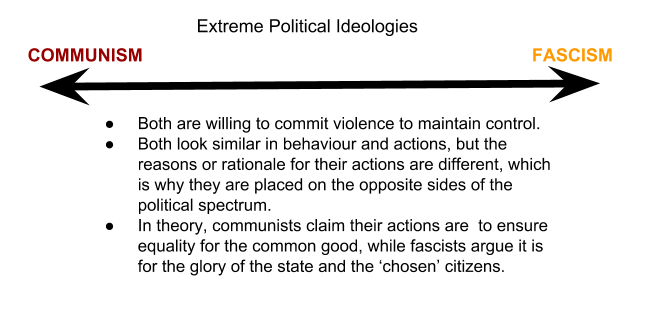
Consider the issue question:
3. Characteristics of Totalitarianism
Characteristics of Totalitarianism
Fascism and Communism are two ideological systems that result in dictatorship. There are many types of dictatorship or political control around the world. A totalitarian political system is one in which the government has almost total control over the lives of its citizens. The government does not obtain its power or legitimacy from the support of the people, and it stays in power by state-sanctioned violence, propaganda, and indoctrination.- Is it possible for totalitarian regimes to value any of the principles of liberalism?
- What values and beliefs lie behind totalitarian rule?
- Do you think these ideas are justified? Explain.
Possible Advantages |
Possible Disadvantages |
|
|
- How well does the film reflect your understanding of totalitarianism?
- Do you think this film is propaganda in any way, or does it just state the facts?
- have extensive local, regional, and national organization?
- use secret police using terror as a weapon?
- establish professional, cultural, and youth groups to support the leader, often with forced participation ?
- indoctrinate through education?
- control the media, including use of propaganda and censorship?
- redirect popular discontent (use scapegoats)?
4. Emergence of Fascism
Fascism is an ideology that rejects liberal democracy in favour of an authoritarian government. After World War I, two countries in particular - Italy and Germany rejected liberalism in favour of this fascist ideologies.

Why did the German people adopt Nazi (fascist) ideologies?
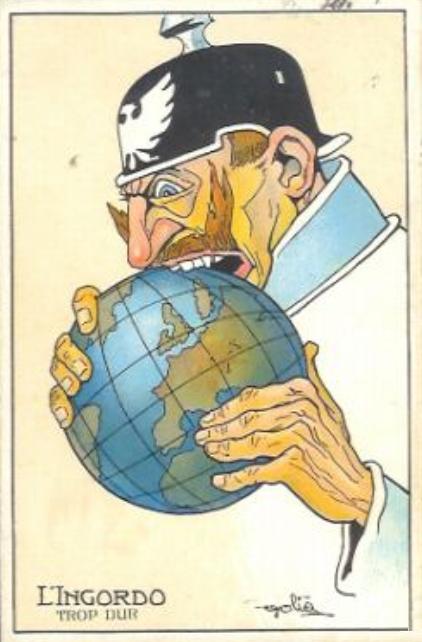
How did the people of Germany reject the liberal democracy that came to power at the end of World War I to support Hitler and the fascist Nazi party by 1933?
Germany had been a powerful empire before World War I (1914-1918),
ruled by Kaiser Wilhelm II who was intent on expanding Germany and its international power.
The French postcard to the left shows the negative feelings in much of Europe towards the Kaiser and Germany because of their expansionist policies.
Although Germany was not the only country to blame for World War I, anti-German sentiments became even stronger after its defeat. When Germany was defeated, Wilhelm was forced to step down.
Treaty of Versailles: At the end of World War I, more than 16 million people were dead and Europe was in ruins. The war ended with the Treaty of Versailles. The victorious nations (primarily France, Great Britain, and United States) wanted to prevent a war of this scale from re-occurring. They wanted to ensure that Germany would never have military power again.
The terms of the treaty included the following:
- German admission of guilt for causing World War I
- Permanent loss of German territory
- German payment of heavy reparations-in today's terms, over US$400 billion
- Limits of the German army 100 000 soldiers and German navy to 15 000 men and few vessels, and no military equipment to be manufactured or imported
- The Rhineland (bordering France, Belgium, and Netherlands) to be demilitarized
- Kaiser Wilhelm to be tried as a war criminal
Economists estimate that in today's terms, the Treaty of Versailles would have taken until 1988 to repay. In fact, Germany finished repaying the damages in 2010.
Many Germans were angry with the government for signing a treaty that they believed stood in the way of their economic success as individuals and a nation. Some, such as Adolf Hitler, believed they should not have admitted defeat in World War I and that the German army had a strong chance of winning that war.
The shame they felt as a nation was demoralizing. Fear of communism, political extremism, hostility from the victors of World War I, and a faltering economy all presented challenges.
Notice the archival photo of Germans protesting the 'brutal peace' brought on by the Treaty of Versailles in front of the Reichstag May 15, 1919.
Between 1919-1933, an increasing number of Germans supported Hitler's National Socialist Party. Why?
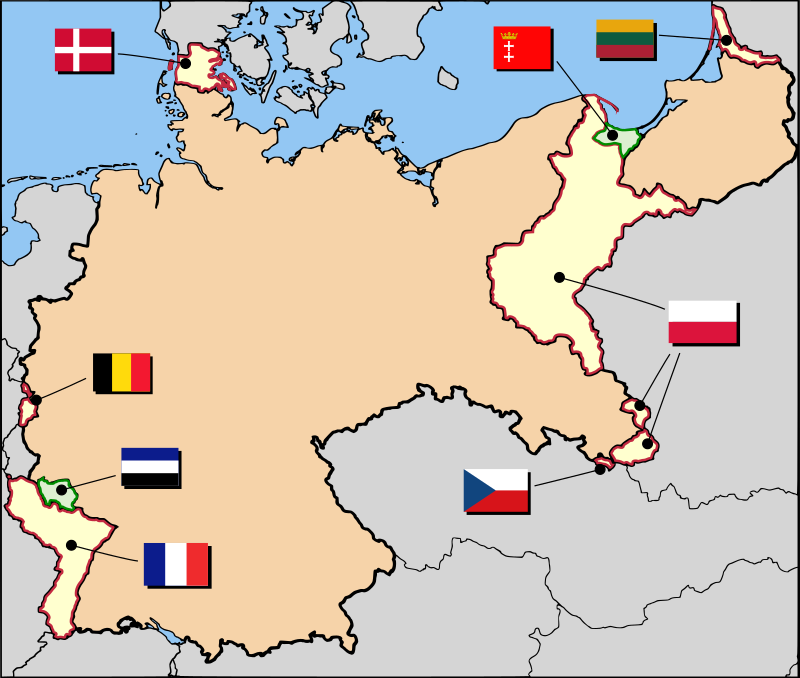
The brown-beige shaded area shows the borders of Weimar Germany in 1919.
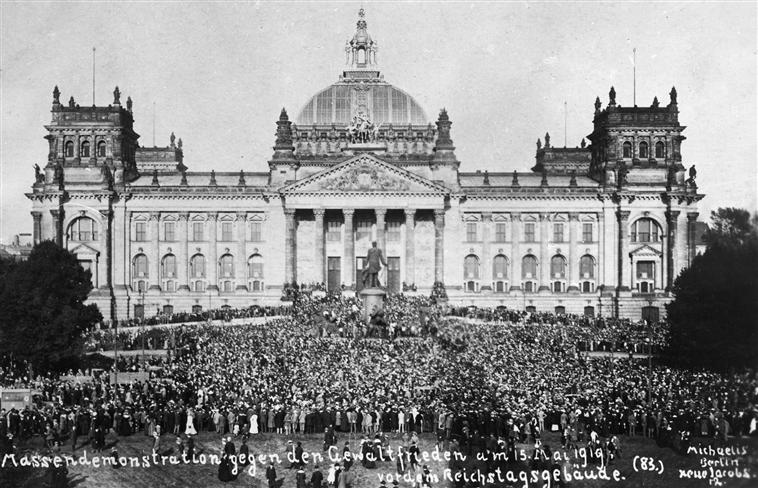
Adolf Hitler was a powerful public speaker and the leader of the National Socialist Party. He was able to capitalize on the anger of the German people towards the Treaty of Versailles and the perceived failure of the Weimar Republic to improve the lives of ordinary people. He drew upon common suspicions of the Jews who many blamed for the financial crisis and the rise of communism. He inspired hope and confidence in the Germans by promising them not only employment and economic success but also a return to the traditions of the past and what many saw as their rightful place as a powerful Third Reich, or third empire.
Don't be fooled though - the Nazi party was not left wing or socialist as we have studied it. In fact, it was a far, right wing violent ideology.
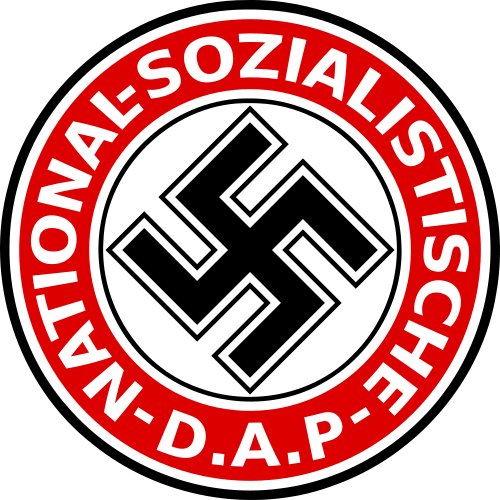
Nazi is short for the National Socialist German Worker's Party
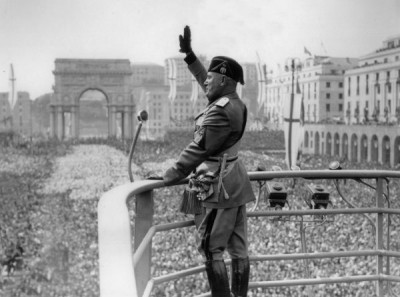
Public Domain

Fascism as an ideology first found a foothold in post WWI Italy before being adopted by the Nazi Party in Germany.
Benito Mussolini became Prime Minister of Italy in 1922 and remained in power until 1943. Mussolini called himself 'Il Duce'
(the leader). Italian fascism included elements of nationalism, corporatism, expansionism, social progress, and anti-communism, using techniques of propaganda and censorship to retain control of the people.
How did Hitler & the Nazi's Gain Power after World War I?
First Attempt at Power: The Munich Beerhall Putsch (military overthrow) of 1923 was Hitler's first attempt to obtain power. He and other party members, backed by several hundred SA 9 (or Stormtroopers) entered a large beer hall and told the crowd that they had overthrown the elected government. His attempted violent takeover failed, and he was sentenced to treason and jailed.
Hitler was eventually pardoned in 1925. The failed coup led Hitler to enter politics and gain power through legitimate means.
It took several years, but by 1928, Hitler and his Nazi party began to make steady gains in national elections.
Although the German government prospered until the Great Depression began in 1929, the depression had a negative effect on Germany. Crippling war reparations combined with the desire of the German people to redeem themselves internationally made Germany vulnerable to a strong leader who promised them hope, even if it meant the loss of some freedom.
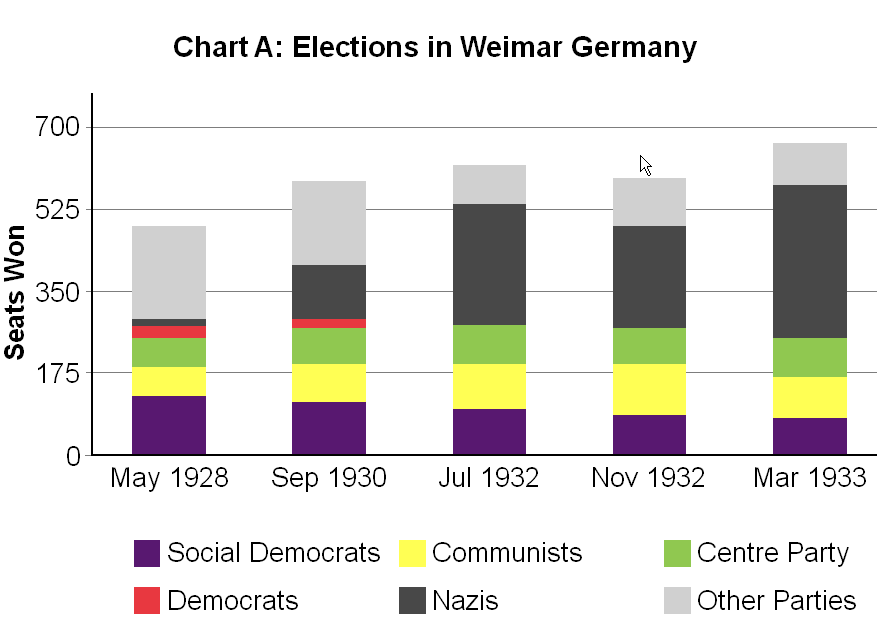
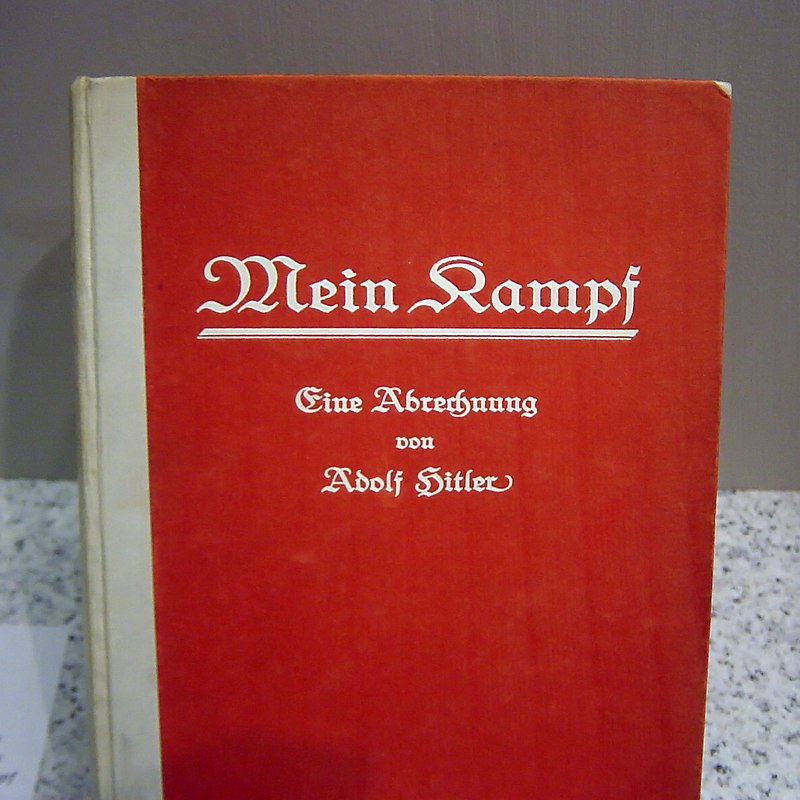
Chancellor of the Reichstag: The year following Hitler's election in which the National Socialist Party received a third of the popular vote, Hitler was appointed Chancellor. A few days after his appointment, someone tried to burn the Reichstag,
and Hitler used the threat of a further communist takeover of Germany to convince President Hindenburg to revoke civil liberties so order could be maintained.
Hitler began to exert total control over the government; he eliminated any opposition, and overturned democratic practices. Less than a month after the Reichstag fire, the Enabling Acts were passed; these gave Hitler and the Nazis
complete control of the state. These were set to last for four years, but they were renewed in 1937, 1941, and 1944.
The Reichstag Fire Decree and the Enabling Acts included the following provisions:
- restrictions on freedom of opinion, freedom of the press, and freedom of organization and assembly
- elimination of private phone calls, mail, and telegrams
- elimination of the need for search warrants
- passing of laws without approval of the parliament
- banning of all political parties except the Nazi Party
In June 1934, Hitler ordered the head of the SA to be assassinated. Hitler saw the powerful and popular army as a threat to his leadership. A common tactic in dictatorships is the elimination of any threat to the leader's authority. When Hitler
eliminated his own men murdered, this became known as the "Night of the Long Knives".
When the old President Hindenburg eventually died in August of that year, Hitler declared himself the sole Fuhrer, or leader.

- Why did the German people reject liberalism?
- What values and beliefs underlie the ideology of fascism?
5. Life in Nazi Germany
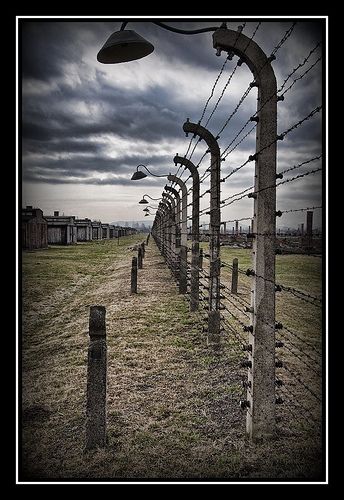
When you think about Nazi Germany, what images come into your mind?
- Adolf Hitler and his mesmerizing speeches?
- Nazi rallies where thousands raised their arms in salute to the Führer, calling out "Heil Hitler"?
- Tanks rumbling across recognized borders?
- Military expansion leading to world war?
- Concentration camps where millions were put to death?
Many atrocities were committed by the Nazis whose fascist ideology and totalitarian practices led to war and untold suffering. But what did they believe? How were they able to take control of a liberal democratic nation filled with reasoning people and convince them to persecute people according to race, ability, and gender orientation? How were they able to convince a nation that their race was superior to all others and deserved to rule all neighbouring lands? How were they able to organize the people to go into battle for the second time in just over twenty years?
Although we know that life for Jews and other members of persecuted minorities was tragic, what was life like for the average German?
Hitler was not unique in his hatred of the Treaty of Versailles or his belief that the Jews were to blame for most of Germany's problems. He drew from history and folklore to rekindle the pride of Germans in their history, which gave them hope for the future. Ethnocentrism, or the idea that certain races were superior to others, was common in Great Britain and United States at that time, so the idea that the German or Aryan people were part of a superior class of people was not at all new.

- belief in the nature of human beings,
- how society should be structured,
- how they interpreted history, and their vision for the future.
Also consider how the ideology deals with the themes introduced in Unit One: nation, class, race, relationship to the environment, gender, and religion.
The Corporate Economy
Remember, fascism is a political ideology but it does not have a set of economic ideas. The Nazi economy combined elements of individualism and collectivism but it was hardly liberal. Its domestic economy was aimed completely towards the goals of the government, including eliminating unemployment, increasing military production, and increasing consumer goods to raise the standard of living for the lower and middle classes. Trade unions were banned to eliminate labour unrest, but workers had no way to improve working conditions.Although the Nazis believed in the ownership of private property, it was conditional upon how that property was used. If corporations and their owners put personal profit ahead of achieving national goals, their factories could be nationalized. Individuals and corporations were allowed to own private property, but they were controlled by the state. Government regulations, subsidies, quotas, tariffs, and a complex taxation system meant that companies that followed Nazi rule were rewarded while others ran the risk of losing everything, including their lives.
- Volkswagen, BMW, Porsche, and Ford all used prisoners of war to work in their factories.
- Krupps and Bayer had production plants in Auschwitz (the huge concentration camp).
- Hugo Boss designed and manufactured the SS uniform.
Adolf Hitler
Techniques of Dictatorship to Maintain Control:
- Controlled Participation through extensive local, regional, and national party organizations, groups and mass rallies. Therefore citizens (supporters) feel as if they 'belong'. Establishment of professional, cultural, and youth groups
that support the leader, often with forced participation.
- The use of force and terror used as a weapon to ensure citizens follow the government and do not rebel. This includes the presence of secret police to promote a climate of fear and distrust.
- Indoctrination through the use of propaganda and control of the education system from an early age. Total control of all forms of media ensure only the government's message is communicated to the people. Widespread use of censorship.
- Redirection of popular discontent towards scapegoats or people the government claims is to blame for all of the country's problems. This directs the people's anger and blame for problems onto another group away from the government.
What techniques of dictatorship are reflected in the propaganda poster?

- What ideas are presented about the rejection of liberalism?
- What values and beliefs lie behind the ideology of fascism?
- What techniques of dictatorship did Hitler and the Nazis use to gain control?
6. QUIZ 4.1: NAZI GERMANY
- Do the quiz
- Reward yourself with a snack
7. The Holocaust
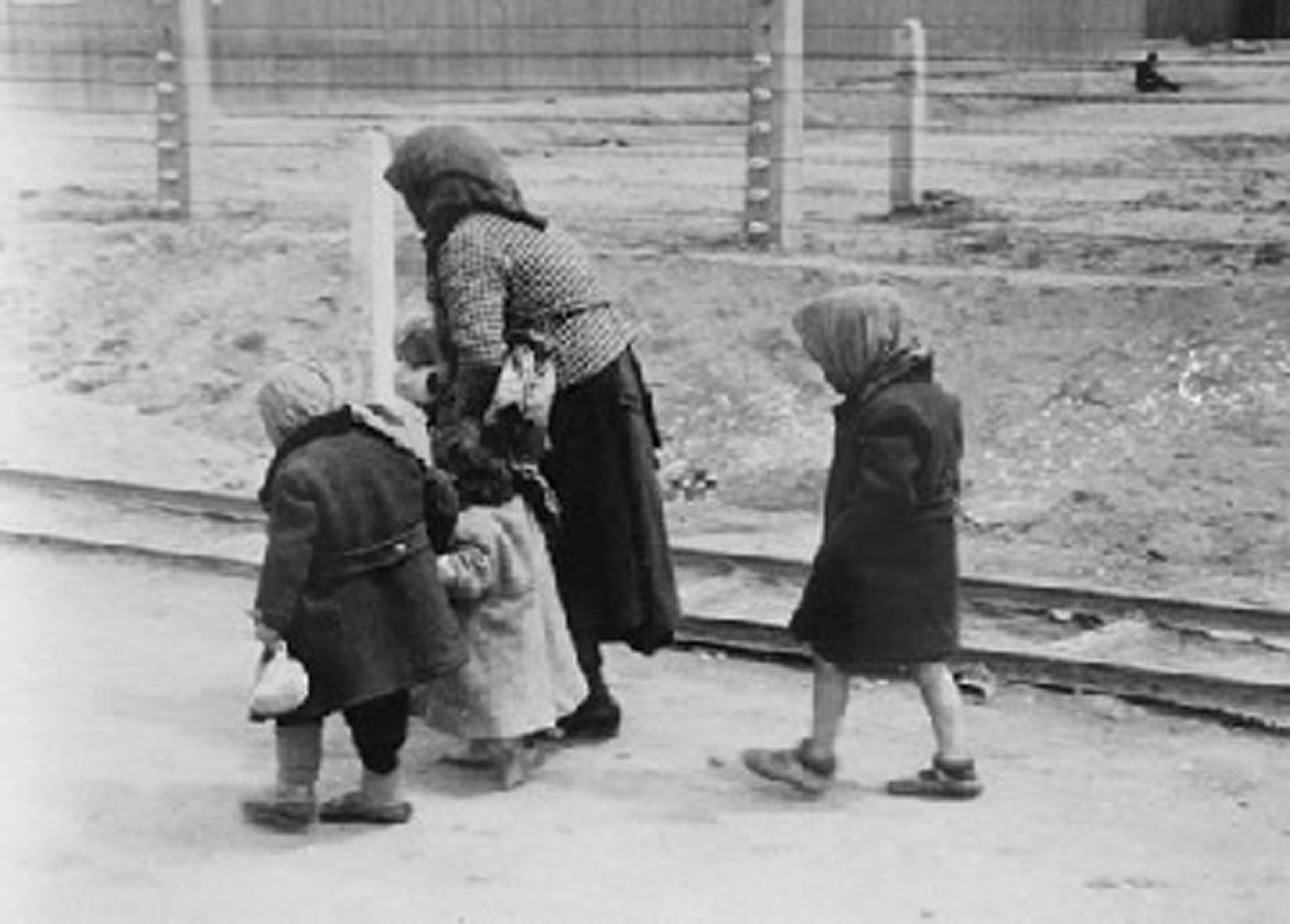
In the picture, a hunched old woman walks with several children beside a railroad track. The woman and children all have their heads covered and bowed. One of the children is helping the smallest one walk. The body language of the old lady and the child who is walking behind suggests that they are miserable yet prepared to accept their fate. Beyond the group is a strong and high barbed wire fence, and beyond that, a barren field with a person seated against a concrete wall in the far background. The overwhelming mood of the image is of dejection and resignation.
One student wrote this:
When she left the camp, she took the album with her and later allowed the photos to be reprinted for the Jewish community. The negatives were later discovered in a museum. The photos were later used in the Auschwitz trials in which those who ran the camp were tried for their actions. Lili, who by then had emigrated to United States, was brought to testify at the trial.
Using a technique called scapegoating, or the direction of popular discontent, Hitler and the Nazis blamed the Jews for everything that had gone wrong with Germany. They drew upon the already existing belief of some Germans that the "Aryan" race was superior to all others, and the anti-Semitic view that was already present in Europe and North America, that the Jews were to blame for the death of Christ and the collapse of the economy.

They practiced eugenics or enforced sterilization with the goal of allowing only those with desirable traits to reproduce. As a result, anyone who was disabled or deemed mentally deficient was sterilized. This went further when thousands of people who had been institutionalized were put to death. Others who were considered inferior and put to death included the Roma (Gypsies), blacks, homosexuals, and some religious groups such as Jehovah's Witnesses.
Under the new laws introduced by the Nazis, Jewish people were at first prohibited from holding certain jobs. Each Jew had to wear a yellow star to be identified as a Jew. Thousands of Jews fled the country, and those who tried to help them were punished severely. All Jewish children were expelled from school, and all Jewish businesses were closed. The Jewish people were rounded up, put on trains, and sent to concentration camps where millions were put into forced labour and killed eventually. An estimated 9 to 11 million people died, including 6 million Jews.
What values and beliefs lie behind the ideology of fascism?
How did the Nazis use the techniques of dictatorship to maintain total control?
For more about Nazi Germany and the Holocaust, go to the US Holocaust Memorial Museum.
8. WWII
By the mid 1930s, many nations had come to realize that the terms of the Treaty of Versailles were not fair to Germany, and they were prepared to offer some concessions. Although the Treaty of Versailles forbid Germany from building their military, especially in the Rhineland, they proceeded to do just that. Soldiers were trained in the thousands and military equipment built or bought.
Why did other nations not step in? Read on!
Expansionism
Hitler and the Nazis believed that Germany needed more living space, or lebensraum (living room). Their first move was the annexation (or Anschlus) of Austria in March 1938 although Austria had never been part of the German Empire. Although other nations of Europe protested, none wanted to start another war with the Great Depression not yet over and World War I still on everyone's mind.
In September 1939, the Nazis marched into the Sudetenland, a German-speaking area of Czechoslovakia.
Appeasement
Germany promised that this was the end of their expansion. The other nations of Europe wanted a diplomatic solution, so they agreed. Under the Munich Agreement, Germany, Britain, France, and Italy agreed that the Sudetenland would be returned to Germany and that no further territorial claims would be made by Germany. The Czech government (of which the Sudetenland was a part) was not invited to the discussion. The Munich Agreement was seen generally as an example of securing peace through diplomacy. In March 1939, Germany took over the remainder of Czechoslovakia.
War is Declared
Germany entered Poland on September 1, 1939, where they began a blitzkrieg, or lightning war that involved a heavily militarized attack, complete with tanks and other powerful weapons. France and most of the nations of the British Commonwealth declared war on Germany immediately.Other nations soon followed, including the Soviet Union after the German invasion of USSR in 1941. Germany allied itself with fascist Italy. On the other side of the world, Japan was at war with China and other Asian countries. After Japan bombed
Pearl Harbour in Hawaii on December 7, 1941, United States joined the war.
More than 70 million people died in World War II (1939-1945), the deadliest conflict in history.
Do you think these ideas are justified? Explain.
9. Emergence of Communism in Russia
Emancipation of the Serfs
In 1861, a huge liberal reform occurred with the emancipation of the serfs. Twenty-three million serfs were given the rights of citizens, including the right to marry without the consent of the landowner, the right to own property, and the right to own a business. Peasants who had been field workers could buy land from the landlords; household serfs gained their freedom but no land. However, this change was not entirely successful because many freed serfs could not afford to buy enough land that would feed their families. They borrowed money to buy land, and their loan payments were far more than they could afford.Russian Revolution of 1905

Courtesy International Institute of Social History, Netherlands
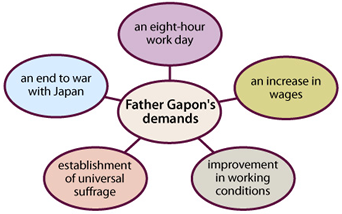
Bloody Sunday triggered a wide range of reactions in the Russian Revolution of 1905. Protests, strikes by workers, and ethnic uprisings occurred across the country, leading to the eventual establishment of the Duma, or Russian parliament. Although the Czar promised greater freedoms for the people and power to the elected government, in reality he had no desire to give up his absolute control of the country.
Failure of Democratic Reforms
The first Duma lasted for only ten weeks. The second Duma was composed of Social Democrats, Social Revolutionaries, and members of the right wing. Accused by the Prime Minister of plotting an armed overthrow of the Czar, the second Duma was dissolved
quickly. New rules that gave greater power to landowners ensured that the rich had greater control, so the unrepresentative Third Duma lasted for its full five years. World War I began in 1914, causing more problems for the Russian people. Food shortages, strikes by workers, and huge losses in the war all caused great anger towards the Czar. As in other industrializing countries, many farm workers had moved to the cities, resulting in a large urban labour force, many of whom were unemployed and starving. There was also a growing class of business people and professionals. These people were influenced increasingly by new and revolutionary political ideas.
Provisional Government
The Fourth Duma agreed to suspend its operation for the duration of World War I, but its members became increasingly unhappy with the way the Czar and the military were handling national affairs. The February Revolution of 1917 led to the abdication of the Czar and the formation of the Russian Republic. Its government was called the Provisional Government, also sometimes known as the Kerensky Government after its leader, a prominent socialist.Although most Russians wanted to see Russia withdraw immediately from the war, it launched a new offensive instead, weakening its public support. The government was victim of a power struggle between left and right. Economic chaos added to the problems. Production decreased, industries shut down, the cost of living increased, and there was mass unemployment. Many of those who still had jobs went on strike. Foreign debt skyrocketed, and the country was on the verge of bankruptcy.
Russian Revolution 1917
By the fall of 1917, thousands of peasant uprisings were directed against landowners and attempts to punish the rioters enraged them more. Soldiers and sailors declared they no longer recognized the authority of the Provisional Government and refused
to follow orders. The October Revolution of 1917 saw Lenin's Bolsheviks take power and a civil war followed from 1917 to 1922. It ended with the formation of the Soviet Union. During this time of turmoil, revolutionary groups assassinated political leaders and civil servants, and the government responded by executing those they thought were responsible. More than 10 000 people were assassinated or executed. The failure of capitalism and one unsuccessful parliament after another led the Russian people to consider other ideological perspectives.
Communism emerged in the Soviet Union partly as a rejection of liberalism but also as a rejection of a capitalist system based on hereditary wealth and power in which the average citizen was poor, owned very little property, and had little or no autonomy. One Duma after another, followed by the more democratic Provisional Government, showed the people that parliamentary democracy was ineffective and would not bring about any real change.
- pages 164 to 165 - the massacre of Russian workers
- pages 168 to 170 - "The Need for Change in Russia"
- pages 169 to 170 - "Lenin and the Rise of Communism"
- pages 170 to 171 - "Ineffectual Reform"
- pages 171 to 172 - "Communism is Established"
- What values and beliefs lie behind the ideology of communism?
- Why did the Russian people reject liberalism in favour of communism?
Lenin and Leninist Thought
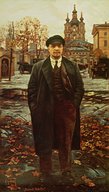
© Courtesy Scholar's Resource
Lenin is considered to be the father of communist Russia. He was influenced strongly by the ideas of Karl Marx and Frederich Engels, but he developed other theories of his own. His brand of communism, known as Leninism, differs significantly from Marxism. He was the first President of the Union of the Soviet Socialist Republics (USSR).
Marxist theory and Lenin's communism differ. Marx believed that the working class would naturally rise up on their own to take over the means of production. Decades after Marx wrote The Communist Manifesto, Lenin did not see the proletarian revolution happening in Russia. His country was not industrialized, and most people were illiterate peasants.In most of the Western world, the working class was getting richer and obtaining more rights and political power. Lenin believed that the Russian proletariat or peasant was not achieving its fair share of power. Because most working people laboured for 10 to 12 hours per day, they did not have the time or the education to develop a full understanding of communist theory. At best, they would be able only to organize themselves into trade unions to fight for pay and working conditions. To gain the power over society they deserved, they would need to be led into revolution by a highly disciplined group of intellectuals. This was a divergence from Marxist theory into Leninist communism.
Lenin believed that led by him, his Bolshevik party would lead Russia into a communist society based on egalitarianism. Learn more about how Lenin rejected liberal principles and established a communist dictatorship.
How the communists developed their support base
Russia was a huge and mostly rural country with a limited communications network and a high rate of illiteracy. How did the communist government reach the masses to deliver its message about the promise of a socialist state? The communist
government used visual images to reach the general population with a number of simple messages. These simple, colourful posters achieved several goals. To consolidate power, the government identified the enemies of communism, provided educational messages about hygiene, health care, and agricultural production, and encouraged solidarity and support for the communist party. Through these posters, the communists encouraged the peasants and factory workers to support the communist movement and its promise for a fairer world.
10. Communism in the Soviet Union
Although the Communist Revolution began with the ideas of collective responsibility, cooperation, and equality for all, the Soviet Union soon deteriorated into a totalitarian state in which individuals had few rights and freedoms, especially under Lenin's
successor.
Using the same techniques of dictatorship, Stalin consolidated total control over the Soviet Union. He implemented collectivized farms, nationalized industry, and was responsible for a series of Five-Year Plans that set ambitious
targets for industrial and agricultural production.
Stalin's plans for industry and agriculture led to protests by many of the original communist founders of the USSR who felt his version of socialism was far removed from the vision they held. He used the state police increasingly to control the population. The Great Purge of the 1930s led to the arrest, execution, and/or imprisonment in forced labour camps of many senior party members. Forced labour camps were used for those who disagreed with Soviet policies.

How do the characteristics of communism above differ from the practice of Lenin and Stalin in the Soviet Union?
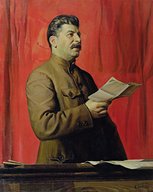
Joseph Stalin
Deaths due directly to Stalin's policies are estimated in the millions, not including those who died from famine. After Stalin's death, the communist party maintained control of almost all aspects of people's lives.
- How did the Soviet Union reject liberalism?
- How did Stalin maintain total control over the people?
- How did the command economy reject liberal economic principles?
- The Whisperers: Private Life in Stalin's Russia by Orlando Figes
- The Kulak's Daughter by Gabrielle Goldstone
11. Life in the Soviet Union
What was life like for the average person in the Soviet Union?
The Communist Party of the Soviet Union (or CCCP) ruled from 1917 until 1991. During this time, the people saw many changes to their way of life. In countries with liberal forms of government, citizens elect leaders to reflect their desires, but the Soviet Union was a dictatorship by the communist party. The Communist Party was led by various leaders, each with hid own approach. Lenin was a revolutionary who promoted collectivization and central planning to ensure communist success. His successor, Joseph Stalin, used terror and force to maintain control. Their different approaches had strong effects on the daily life of the people.As you read about how communism was practiced in the Soviet Union, compare those actions to the theory of communism as presented below.

Centrally-Planned/Command Economy
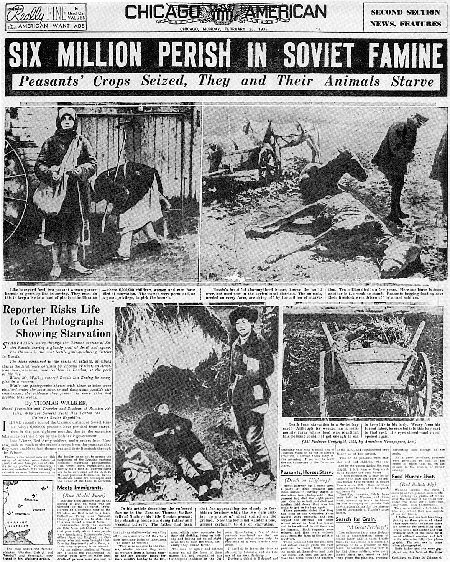
Under a command economy, everyone worked for the good of the whole. Private property was gradually abolished and everyone was guaranteed employment. Although it meant that everyone received some income, it also caused great unrest, especially among the kulaks, a class of land-owning farmers who lost their land when Stalin initiated his infamous collectivization policy.
Collectivization was one of the most profound changes in the lives of most citizens. Russia had a long tradition of collective farming in one form or another, but under communist rule, large communes were established in which individuals no longer owned their own land or profited from their individual labour. (Read more... )
Stalin's initial efforts to collectivize farming led to a massive famine, called the Holodomor, in which millions perished.
Industrialization

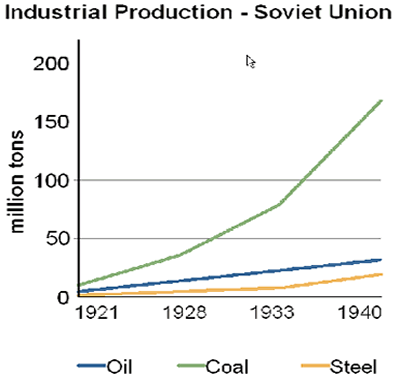
Consider these two charts to the left. What do they tell you about the success of central planning over time in the USSR?
Political Control
On the previous page, you learned how the communist party spread its message through the use of posters. The Soviets, similar to the Nazis, developed programs of indoctrination and propaganda to support and control the people. Other techniques included- extensive local, regional, and national organization
- secret police using terror as a weapon
- establishment of professional, cultural, and youth groups that supported the leader, often with forced participation
- redirection of popular discontent (use of scapegoats) (In the Soviet Union, the kulaks and the church were often blamed for the problems faced by the people.)
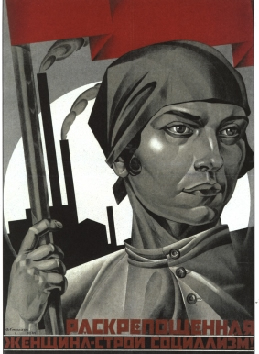
© Liberated woman - build up socialism!
1920s Poster
Women were appealed to through the promotion of their status as equal members of society.
Youth were essential to the Soviet Communists. Similar to the Nazis, they knew that control of the young was a key element to success. The Communist Youth League or Komsomol was formed under Lenin. Young people aged 14 to 28 were encouraged to join this organization while younger children could join the Pioneers. By the 1970s, Komsomol had tens of millions of members. Nearly two-thirds of the present adult population of Russia once belonged to the organization.
-Lenin
Secret Police
The Cheka, or secret police, was established in 1917 to arrest "enemies of the state"-those who protested communist party rule. Later, this became the KGB, which employed thousands of people as informants, police, and guards in prisons and labour camps. By the mid-1980s, there were an estimated 500 000 KGB agents and 2 million volunteer informants. Internal passports meant that citizens were monitored as they moved around Russia. The "labour book" required by all adults was a record of work history and was held by the employer, preventing worker mobility.Elections
Participation in elections was controlled. Although non-communists could run for office, this was only with the approval of the Communist Party. In early elections, voting was done with a show of hands with the idea that people should declare their views openly. This led to low voter turnout. Later, elections were by secret ballot, but with only one candidate on the ballot. Those in favour of the candidate dropped the ballot into a box unmarked-those not in favour had to mark the ballot which would make their view public to the polling officials who could then report them to the secret police. Official voter turnout was 98%, but much lower in reality.Civil Rights
In theory, each of the four constitutions of the Soviet Union guaranteed citizens rights to employment, leisure, health care, housing, education, and old age care. They were to have equality of gender and freedom of conscience, speech, religion, the press, and assembly, as well as protection of privacy. Literacy increased and women experienced great gains toward equality under Soviet rule. However, many rights were upheld only as long as they were consistent with Communist goals.Dissent
Dissent was an integral part of the process when the USSR was first founded, but later any criticism of state policy was considered anti-Soviet and punishable by imprisonment or death. Notable dissidents Aleksandr Solzhenitsyn (a novelist) and Andrei Sakarov (inventor of the Soviet H-bomb) were able to get their messages about oppression in the Soviet Union to the outside world. Solzhenitsyn believed that the Soviets could not rule without the threat of imprisonment and its economy could not succeed without the use of forced labour camps. He wrote about his experiences as a prisoner in one of these camps and conducted research about the camps. His book, The Gulag Archipelago, was published through the underground press or samizdat, and it was published in the West. He was exiled from the Soviet Union. Sakarov protested the build-up of weapons and believed that the threat of world destruction by nuclear war was very real. His essay, Reflections on Progress, Peaceful Coexistence, and Intellectual Freedom, was published in samizdat and in the West. He continued to protest against Soviet military expansion and advocate for human rights. As a result, he was held under house arrest for many years.- How did the Soviet Union reject liberalism politically and economically?
- What values and beliefs lie behind the ideology of communism?
- What techniques of dictatorship were used to maintain control?
Read The Gulag Archipelago by Aleksandr Solzhenitsyn.
12. Propaganda
4.1.10 The Use of Propaganda
Propaganda is the deliberate use of words and/or images to give a certain message. Propaganda is used frequently by governments and other organizations to convince people that a certain idea, policy, or cause is correct or advantageous. It can include deceptive or distorted information that is spread systematically through the media.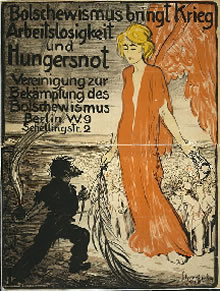
Courtesy United States Library of Congress
Propaganda can be spread through news articles, television reports, posters, speeches, billboards, radio, and the Internet. It can include the written word, moving images, and visual representations.
Both the Nazis and the Soviets were masters of propaganda. Consider the two posters. What messages are they promoting? What techniques are used? What ideological perspectives do they promote?
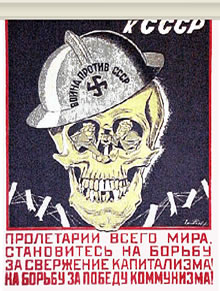
War Against the USSR
© CCCP State Press, 1930 Courtesy Swarthmore College
13. Conflicting Ideologies
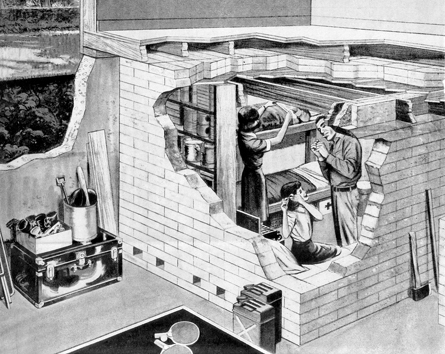
Conflict between the two superpowers of the United States and the Soviet Union dominated world politics from 1945 until 1990 when the Soviet Union collapsed. During this period, capitalism and communism competed. Each side tried to prove that its political and economic system was better at achieving national goals and meeting the needs of their citizens. Economic influence and propaganda were used to promote support for both sides.
Not only did the two sides try to become powerful in terms of influence and wealth, they also built up huge arsenals, supposedly to defend themselves in case of attack from one another. Also, nuclear weapons were built and stockpiled, and the possibility of a nuclear attack that could destroy the entire world brought fear to people everywhere, including neutral or non-aligned nations. The sketched image to the left shows a bomb shelter built by an American family to protect itself in the case of a possible nuclear war.
Face-to-face conflict also occurred in many parts of the world in which the militaries of small nations were supported with weapons and personnel from both the Soviet Union and the United States.
In this section, you will explore the conflicts that occurred during the twentieth century between the two world superpowers of United States and Soviet Union.
- How did conflict between opposing ideologies shape our modern world?
14. The Cold War Begins
In fact, any form of collective action taken by groups in North America between the great wars led to immediate fears of a communist uprising. This paranoia was often a perception rather than a fact and is often referred to as 'the red scare' after the red flag of the Soviet Union. As a result, many liberal societies behaved illiberally in their attempt to erase any possibility of communism. This reactionary behaviour intensified throughout the Cold War.
|
Why call it a Cold War?
During World War II, ideological differences between the West and the Soviet Union were put aside in their collective efforts to stop the spread of Nazism. Once this common enemy was defeated, fissures or cracks in this alliance
began to grow.
From the end of World War II until the collapse of the Soviet Union in 1990, the superpowers
of the United states and the Soviet Union and their allies engaged in a "cold" war, which was unlike a "hot" war in which direct fighting on each other's soil occurs.
The Cold War included a continuous state of political conflict,
military tension, and economic competition that was characterized by military coalitions, the deployment of the conventional military, the nuclear arms race, espionage, proxy wars, propaganda, and a competition to see who could become the most
technologically sophisticated. This included the Space Race, a competition to see who could dominate outer space.
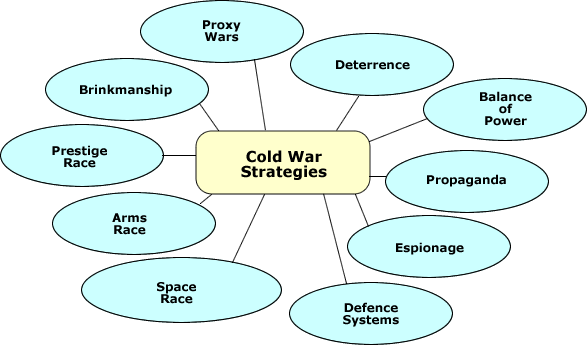

British Prime Minister Winston Churchill, U.S. President Franklin Roosevelt, and Soviet leader Joseph Stalin met at Yalta in February 1945 to discuss their joint occupation of Germany and plans for postwar Europe.
One of the key purposes of the meeting was to ensure Germany would never regain its power. This meant dealing with the question of how to partition Germany among the allies. The Soviet Union blamed Germany for suffering their catastrophic losses in World War I and II. At the same time, Stalin's troops were liberating Nazi controlled Eastern Europe. However, ideological differences began to creep into negotiations. Stalin wanted a buffer between Russia and the western capitalist democracies. He saw the solution as forcing his recently liberated neighbors to adopt communism.
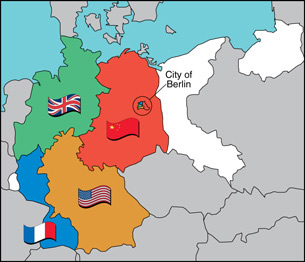
For 45 years, Germany would be a geographic symbol of the ideological conflict between the Soviet Union and the West known as the Cold War.
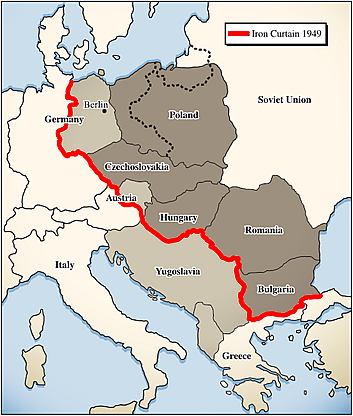
"From Stettin in the Baltic to Trieste in the Adriatic an iron curtain has descended across the Continent. Behind that line lie all the capitals of the ancient states of Central and Eastern Europe. Warsaw, Berlin, Prague, Vienna, Budapest, Belgrade, Bucharest and Sofia; all these famous cities and the populations around them lie in what I must call the Soviet sphere, and all are subject, in one form or another, not only to Soviet influence but to a very high and in some cases increasing measure of control from Moscow.
Winston Churchill - March 5, 1946
You can hear the entire speech here.
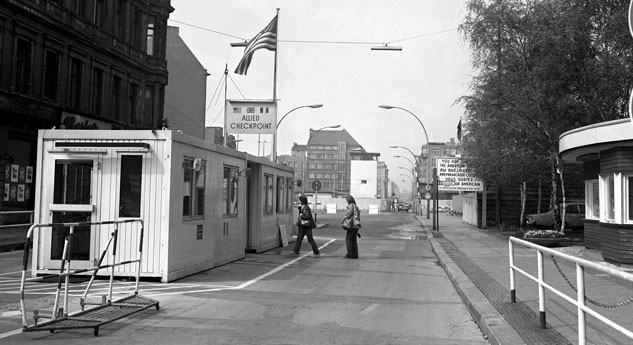
The armed station guarding East Berlin from West Berlin
Germany was divided into East and West Germany with East Germany now under communist rule. Berlin was a divided city located in one portion of a divided country. (See map, page 246 of your text.)
Stalin feared the capitalist influence of the West; in June 1948, he blocked incoming traffic of all kinds into West Berlin. Thus, the 2.1 million people in West Berlin could obtain no supplies from their country, West Germany. The US and allies replied with the Berlin airlift in which a steady stream of airplanes brought food and heating fuel into Berlin. At its height, a plane was landing in Berlin every three minutes.
After eleven months, Stalin lifted the blockade, but by then the stage was set for ongoing conflict between the superpowers.
The dividing line between east and west became an armed barrier between the two areas of Europe. Sir Winston Churchill, a powerful and influential public speaker, called this divide the iron curtain because it represented a division not just of territory but of ideologies.
The Berlin Airlift:
The "Candy Bomber":
|
15. Expansionism and Containment

Expansionism is not a new activity. Recall what you learned about imperialism in Social Studies 10-1; historically, nations have fought to expand their power and influence while others have battled to prevent this from happening.
The same was true during the Cold War.
The Marshall Plan
At the end of World War II, Europe lay in ruins. The cost of rebuilding it was enormous. The United States feared that poverty-stricken post-war Europe was vulnerable to communist takeover.In June 1947, US Secretary of State George Marshall announced the Marshall Plan, a European program of reconstruction with economic assistance from the United States. Under the plan, the United States provided aid to prevent starvation, repaired damaged areas, and began to rebuild the European economy. Aid under the Marshall Plan was offered to all European nations. To receive this aid, nations had to agree follow liberal economic principles, including deregulating prices, eliminating trade restrictions, and preventing the nationalization of industry. The Soviet Union refused any help.
|
Truman Doctrine
The Marshall Plan had two goals: to contain the spread of communism in Western Europe and to stabilize the world according to liberal democratic principles. The Marshall Plan was one aspect of the Truman Doctrine, an American strategy under US president Harry Truman who, with others in his government, believed that the Soviet Union would continue to expand its territory. If one nation fell under communist control, others would fall like a row of dominoes. The fear of this domino effect led the United States to develop alliances with other nations and to establish economic and military policies of containment.
|
The Soviet Response: Molotov Plan and COMECON
Joseph Stalin saw the Marshall Plan and the Truman Doctrine as an anti-communist maneuver. The Soviets established their own program of economic aid called the Molotov Plan and offered it to countries under its influence. The Molotov Plan included bilateral
trade agreements with socialist countries such as Poland and East Germany. COMECON (the Council of Mutual Economic Assistance) was constructed to compete against the Marshall Plan. As a result, Europe was divided into two distinct spheres of influence,
each dominated by one of the superpowers.Read about Expansionism and Containment on pages 241 to 246 of your text, Perspectives on Ideology.
Literal Containment: The Berlin Wall
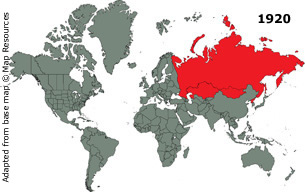
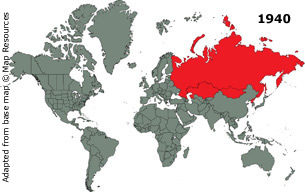
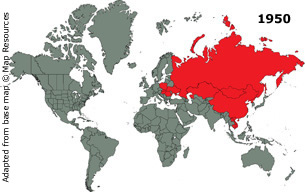
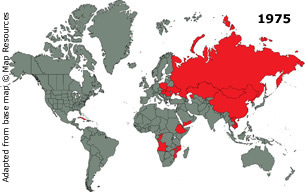
- Read about these liberation movements in "Breaking Free of the Iron Curtain" on pages 247 to 248 of your text, Perspectives on Ideology.
- Was it understandable why Stalin wanted to impose communism in Eastern Europe?
- How did the United States attempt to promote liberal principles in response?
16. Alliances
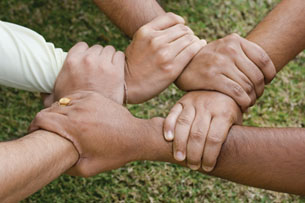
One way for the United States to contain communism was through a defensive alliance with Western Europe and Canada.
Formed in 1949, NATO, short for the North Atlantic Treaty Organization, was an alliance of nations that supported liberal democracy. It began as a political organization, but after the Berlin Blockade, the nations of Europe felt they needed military support. The nations of Western Europe, including much of Scandinavia, as well as United States and Canada were all members. France later withdrew from NATO and began to build its own military, although it supported NATO in many instances, including the Cuban Missile Crisis.
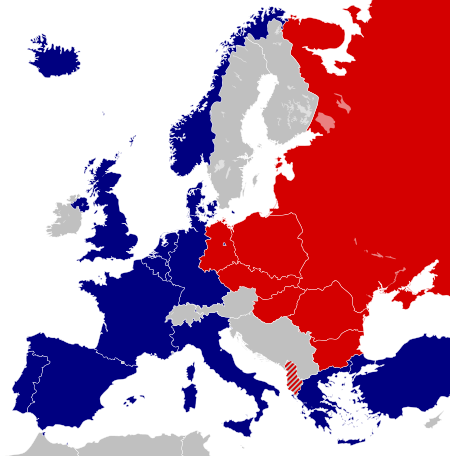
This map from 1973, shows the NATO members in blue (except for Canada and the United States) shown in blue, with members of the Warsaw Pact in red. The non-aligned countries are in grey. Yugoslavia, although communist, left the Soviet sphere in 1948, while Albania was only a Warsaw Pact member until 1968.
Between 1945 and 1991, most of Europe was divided between these two alliances.
With the collapse of the Soviet Union in 1991, most of Eastern Europe joined NATO. After the World Trade Center attacks of 2001, NATO has changed the focus of its operations towards collective defense for its remaining members.
|
NORAD
Another lasting alliance of the Cold War is NORAD, the North American Defence Agreement signed in 1957 between the United States and Canada. The two countries joined forces to defend air space around North America, in case of Soviet attack. Today it is still active and headquartered out of Colorado Springs, Colorado. Used after September 9/11 attacks, the agreement was renewed in 2009.Non-Alignment Movement
As a result of the pressure put on the nations of the world, alliances were formed. Some nations did not want to form alliances with either superpower. They wanted the freedom to choose their own political and economic paths, and they did not want
to find themselves embroiled in a world war or regional conflict as a result of their ties to a superpower. Many of these countries were former colonies who wanted to sever the ties to their former colonial masters.
From this, the Non-alignment Movement or NAM emerged in what was known as the "Third World" during the Cold War-nations primarily in Asia and Africa that were not aligned with either superpower. Today, this term has been replaced with "developing world" with far different connotations.
As the nations of the world gravitated to one power or the other, tension increased.
- How did geography affect the spread of ideologies? Think spheres of influence.
- What happened to the former European colonies between the end of World War II and 1982? Why?
|
|
17. Arms Race and Threat of Nuclear War
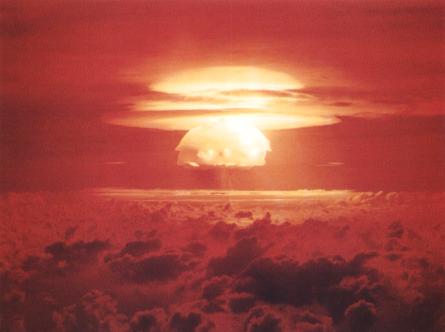
Various actions can be used to deter nations from making the first strike. Threat of economic sanctions and conventional warfare can deter others. Weapons of mass destruction, including nuclear weapons, are a key component in the strategy of deterrence.
Mutually assured destruction was an important aspect of deterrence during the Cold War. Both the United States and the Soviet Union knew that, if one nation used a nuclear bomb on the other, retaliation would include a reciprocal nuclear attack that would ensure the destruction of both nations-and possibly the entire world. They were not prepared to risk a full-scale nuclear war.
|
Nuclear Proliferation
Within the first two to four months of the bombings, the acute effects killed somewhere between 150 and 240 thousand people, with half the deaths occurring on the first day of the bombing and the remainder occurring later from effects of the bomb, radiation sickness, and other injuries. Later, more have died from various kinds of cancers attributed to exposure to radiation released by the bombs. After seeing the devastating potential of nuclear weapons, both the United States and the Soviet Union built and stockpiled nuclear weapons.
At the height of the arms race, the two superpowers owned tens of thousands of nuclear weapons with the power to kill every person in the world many times over.
The image to the right is a poster from the former Soviet Union produced during the Cold War; it states, "Better off proactive today than radioactive tomorrow."
Although both the Soviets and the Americans were developing more powerful nuclear weapons, both sides blamed the other for the arms race and publicly advocated for disarmament, or a reduction in the arms build-up. Apparently, what they meant by "disarmament" was for the other side to disarm while they continued to create their own weapons!

|
Deterrence Today
Both the United States and the Russian Federation continue to own nuclear weapons. France, Great Britain, and China also own nuclear weapons. These five countries have all signed the Nuclear Non-Proliferation Treaty, an agreement in which they agree to work towards disarmament and use nuclear technology only for peaceful means. India, Pakistan, Israel, and North Korea also have "the bomb", but none have signed the non-proliferation treaty.In today's world, the build-up of nuclear weapons in North Korea is an example of deterrence. North Korea is a small, poverty-stricken communist dictatorship with a terrible human rights record. North Korea also has tested nuclear weapons. Because of the threat that the North Koreans might use their nuclear power to attack, other nations may hesitate to use any kind of action against them.
- Robert McNamara's speech about mutual deterrence on page 252
- "Cold War Hysteria" on pages 261 to 262
- "The Threat of Nuclear War" on pages 263 to 264
If You Love This Planet by Terre Nash, National Film Board of Canada
18. The Cuban Missile Crisis
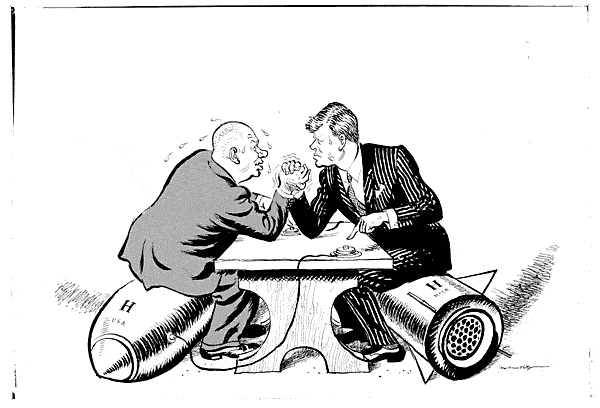
"Okay, Mr. President, let's talk."
Click on image for larger view
Cuba, fearing another invasion, set up nuclear missiles with the aid of the Soviet Union. American military intelligence observed the missiles being set up; this led to the Cuban Missile Crisis, an escalation of tension that pushed the world as close to nuclear war as it has even been.
The crisis occurred in October 1962. The United States demanded that the missiles be withdrawn. The Soviets replied that the missiles were defensive only and did not have the power to reach US territory. After two weeks of extreme global strain, US President John F. Kennedy and the Secretary General of the United Nations reached an agreement with the Soviets in which USSR agreed to dismantle the missiles in exchange for the US promise that it would not invade Cuba.
Brinkmanship occurs when one side tries to push the other as far as possible without giving up anything to the enemy.
|
19. Détente
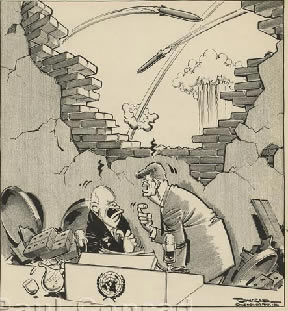
© by Paul Conrad, Denver Times
Image Courtesy Paul Conrad
The cartoon on this page depicts U.S. President Kennedy arguing with Soviet Soviet premier Nikita Khrushchev at the United Nations while missiles are launched overhead.
The mid-1960s to 1979 signified a time of "cooling off" of tensions in the Cold War. This time period, known as détente, showed that countries with differing ideological perspectives can use diplomacy to achieve some cooperation.
The Cold War was an expensive war although it did not involve actual combat. The arms race and the space race were costing a lot of money. Efforts to maintain spheres of influence around the world meant that each government was using economic aid, intelligence operations, and military expertise in many nations to maintain its power and influence. The Soviets hoped that a "cooling off" period would allow them to trade with western Europe, which would lead to economic growth.
As well, the Soviet Union was experiencing conflicts with China, which caused concern. USSR hoped improved relations with the US would lead to a a more peaceful existence. Soviet President Khrushchev promoted the idea of peaceful coexistence, a theory that communist and capitalist nations could live together peacefully, without one side trying to destroy the other. The idea of peaceful coexistence was meant to reduce hostilities between the two superpowers by convincing the United States that the Soviet Union did not have a goal of world domination.
During this period of reduced tension, many conferences and summits were held and treaties and agreements were signed, including agreements about disarmament. Détente ended with the Soviet invasion of Afghanistan in 1979 and the coming to power of US President Ronald Reagan who was elected on a platform of opposition to détente.
- Pay particular attention to the timeline of non-proliferation treaties on the bottom of the two pages.
The period of détente officially ended in 1979, when the Soviet Union invaded Afghanistan. This would have lasting impacts for the region, and the world in the 21st Century.
|
|
20. Proxy Wars
"One man's terrorist is another man's freedom fighter."
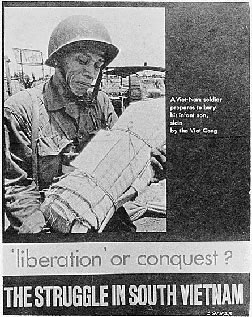
All over the world during the Cold War as the two superpowers battled for supremacy, they fueled wars on the ground in countries far away. They supported guerilla warfare, assassination attempts, funding for mercenaries, and overthrow of both elected and non-elected governments.
Many of these nations had been colonized during the Age of Imperialism. Others had been oppressed by neighbouring nations. These people wanted the freedom to choose their own forms of government, and after World War II, they had been promised self-determination.
Liberation movements occurred all over the world. Both the United States and the Soviet Union wanted to obtain the allegiance of these nations. USSR and US became involved in providing funding, military supplies, and human expertise to nations that were already allied with the opposing power or nations that were non-aligned.
When opposing powers use third parties as substitutes for fighting each other directly, a "proxy war" results. As the global media reported on the actions of the superpowers, people around the world, including those in the superpower nations, began to challenge the actions of the United States and the Soviet Union. If nations were entitled to elect their own governments democratically, what business did the superpowers have of interfering? Furthermore, when the superpowers were sending their own young men and women to fight in places such as Afghanistan and Vietnam, citizens protested the loss of life. Protest by citizens had a part in the involvement of the superpowers in the affairs of other nations.
- Was the containment of communism ultimately successful?
- What were the costs and benefits of fighting these proxy wars?
21. The End of the Cold War
Illegals Program Arrests
The Russian Spies Living Next Door: Thom Patterson, CNN
| August 1945 | June 1948-May 1949 | November 1956 | June-August 1968 | 1972 and 1979 | 1980 |
|---|---|---|---|---|---|
| Bombing of Hiroshima and Nagasaki |
Berlin Air Drop | Hungarian Revolution | Prague Spring | SALT 1 and SALTII | Lech Walesa |
Canadian Events during the Cold War
22. Ideological Conflict within Liberal Society
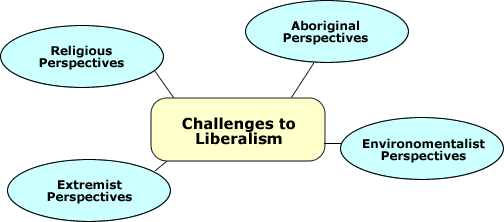
American economist and philosopher Frances Fukayama wondered this when he wrote his book The End of History and the Last Man:
Frances Fukayama
Recent conflicts have proved him wrong.
In our world today, there is a great deal of diversity, not only in race, language, and culture but also in ideological perspectives. Many people and communities continue to hold various beliefs and values that conflict with liberal principles. They may value economic equality over the individual pursuit of profit.
They may consider the well-being of the group (the collective) over the rights of the individual. They may have religious beliefs that contradict or conflict with the individual rights provided in a liberal society. Alternatively, some believe that the environment has to be protected at the expense of private property ownership or economic freedom. These differences lead to conflicting perspectives in a liberal society.
As you learned in Unit One, ideological perspectives are based on individual and collective beliefs and values. In this section, you will explore reasons why some ideas and beliefs come into conflict with modern liberalism. You will continue to examine other challenges to modern liberalism in Unit Five and Seven.
Always consider the section question:
23. Aboriginal Perspectives and Liberalism

People from many cultures, including Canadian First Nations and Inuit peoples, see themselves as individuals, but they also view themselves as just one component of their communities and the natural world. This worldview includes the a belief in collective responsibility and cooperation. Ownership of private property is historically incomprehensible as the land is not seen as something that can be "owned" but rather as something that is to be shared and respected. Membership in a larger whole provides Aboriginal people with a sense of identity and meaning. In many ways, Aboriginal collective thought is at odds with the principles of liberalism.
Since contact, liberalism has been imposed on Aboriginal people. When the first colonists arrived in North America, they imposed their political and economic systems on Aboriginal people. Land was parceled out and purchased by settlers, with reservation land provided for First Nations peoples.
Residential schools were established with the idea that imposing a liberal values would allow First Nations, Metis and Inuit people greater opportunities in Canada. This was not the case.
Even with the adoption of modern liberalism in Canada during the 20th Century, it took until 1960 for Aboriginals to be granted suffrage, or the right to vote. Regardless, the last residential school did not close until 1996. For most of Canada's history, citizenship was based on the degree to which Indigenous people adopted liberal beliefs and property. The recent Truth and Reconciliation Commission has helped unveil the illiberal and last impact of imposing an ideology on entire groups of people, families and individuals. A challenge for Canadian society is how to reconcile the actions of the past with a positive and restorative future based on trust and respect.
The image to the left, by Dene artist Alex Janvier from Cold Lake, is from a 19-metre diameter ceiling dome in the Canadian Museum of Civilization. The painting reflects common Aboriginal values and philosophies: the circular motif represents the circle of life with its spiritual, physical, human, and natural aspects.
|
|
|
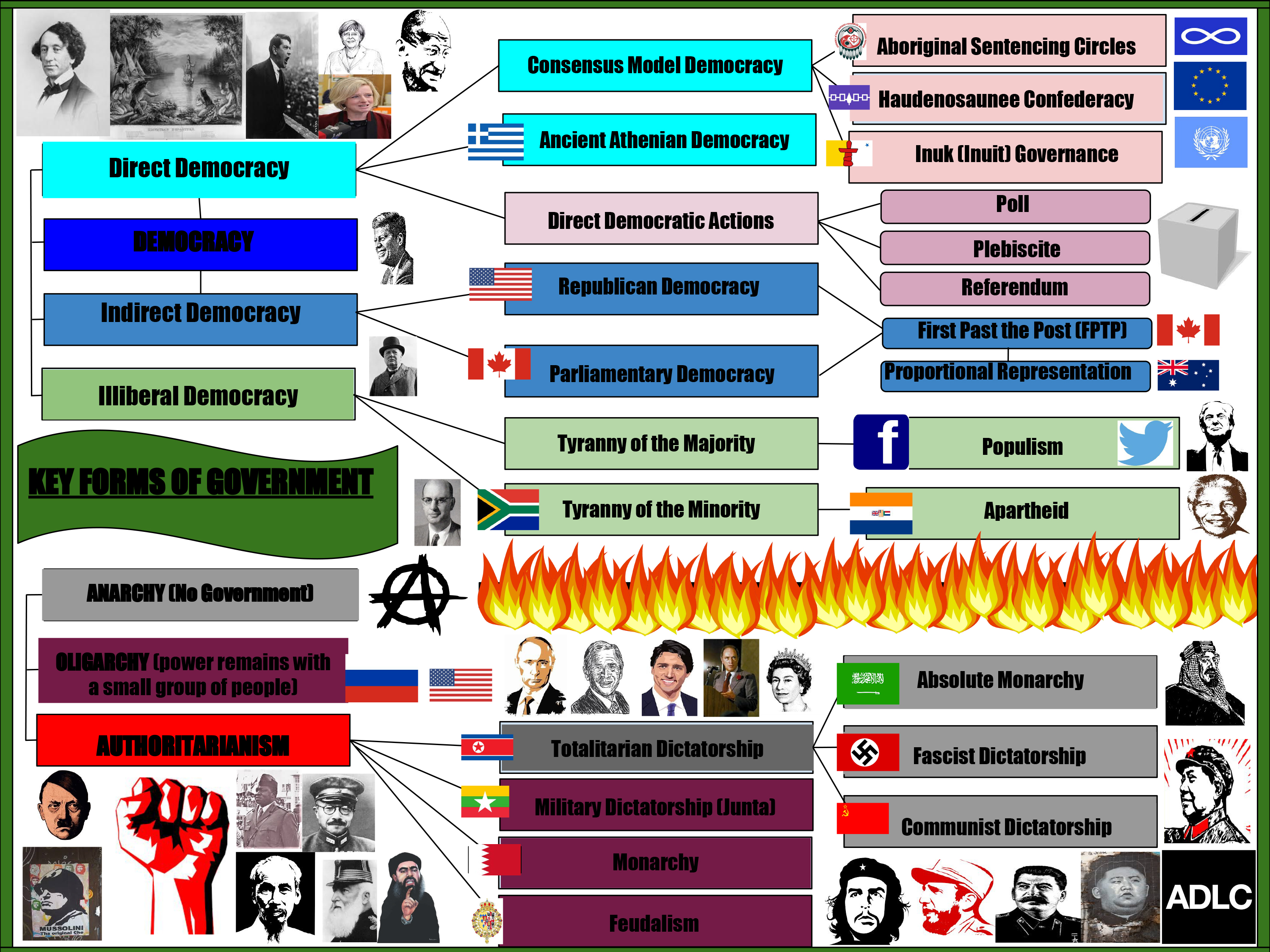
As you read, consider the question:
- What ideas are presented about the rejection of liberalism?
- What values and beliefs lie behind Aboriginal collective thought?
- To what extent is Aboriginal resistance to liberalism justified?
24. Liberalism and the Environment

"Whale Trashed" Steve Sack, The Minneapolis Star-Tribune, MN
How does the cartoonist portray this issue?
brings us many new and interesting products, but many people believe that the continuous manufacture and sale of goods for human use comes at a cost to our environment.
How does environmentalism come into conflict with modern liberalism?
People who believe in environmentalism believe that the non-stop pursuit of wealth needs to be controlled to protect the natural environment for future generations. They believe that one of the essential rights and freedoms all humans should enjoy under liberalism is the right to a healthy and clean environment.
They support legislation that will regulate greenhouse gas emission, reduce pollution, protect endangered species, support sustainable development, and limit the destruction of the natural world. Those who support environmentalism favour a more collectivist approach in which people take collective responsibility for the future of the planet.
Others are skeptical that human activity is harming the environment. They believe that unregulated capitalism has led to unprecedented wealth and health for almost everyone on the planet today. They believe that competition and free-market capitalism have led to better lives for almost everyone alive today. They believe that legislation to protect the environment limits prosperity for all people because it interferes with the very rights and freedoms that have led to the high standard of living we enjoy today.
|
Are you prepared to give up any of your freedoms to protect the environment?
Liberalism and
Extremism
To be an extremist, one's belief system must lie outside of the normal spectrum of beliefs. Extremism is the belief in actions that are considered unacceptable morally, socially, or politically.
Here is what happened to one airline passenger in an American airport:
|
The attacks on the World Trade Center in New York on September 11, 2001, ignited the War on Terror campaign and led to the 2001 invasion of Afghanistan and Iraq in 2003 plus a series of foreign policies known as the
Bush Doctrine.
Foreign policy under the Bush administration after 2001 emphasized the right of the United States to secure itself aggressively from countries that harboured or gave aid to terrorist groups. This approach is associated with the ideals of international intervention to secure American national interests.
In 2001, as a result of the terrorist challenges to western liberalism, the liberal democracy of the United States passed the Patriot Act, which allowed American authorities to
In a country that prided itself on civil liberties, under pressure from extremist groups like al-Qaeda, the U.S. Patriot Act did much to limit those freedoms.
|
The Canadian government passed similar legislation in 2001, the Canadian Anti-Terrorism Act.
|
An area of extremism has been the Taliban in Afghanistan and Pakistan. The Taliban is an extremist group that once ruled Afghanistan in a totalitarian manner. After the World Trade Center was destroyed by the extremist group al-Qaeda on 9/11, 2001, the United States removed the Taliban from power by military force. The Taliban had been allowing al-Qaeda and its leader Osama bin Laden to train their extremist forces there. Canada and many other NATO forces supported the United States in pushing out the Taliban. However, the Taliban have been able to mount a brutal campaign against NATO coalition troops.
During 2008, in the Swat Valley of Pakistan, the Taliban shut down schools. Through an agreement with the Pakistani government, the schools for girls did reopen. But there is still immense pressure on girls not to go to school.
Girls face serious harassment as well in Afghanistan. In 2008, some girls were attacked with acid, causing serious injury to their faces for attending school. During the Taliban's rule, girls were banned from attending school. In the 2016/2017
school year, fewer than 45% of students in Pakistan were girls.
|
25. Neoconservatism & Religous Perspectives
Neoconservatism
One significant movement in modern times that resists modern liberalism is the neo-conservative movement. As the name suggests, neo-conservatives (sometimes referred to a "neocons") believe in a new form of conservativism that closely represents classical liberalism.
Neo-conservatives believe strongly in individualism such as:
- an unregulated free-market capitalism and limited government.
- individuals should pay for these health care and education.
- service providers should have the economic freedom to compete for education and health care dollars.
- they do not support social programs that protect the poor or disadvantaged.
- they do not support those programs that provide assistance to people who have been discriminated against traditionally.
- they do not support government policies that promote greater positive freedoms and social or economic equality.
- they do not accept that governments should provide services such as health care or education.
Religious Perspectives
One fundamental freedom guaranteed under modern liberalism is the right to practise one's own religion.
- But when religious practices contradict the rule of law and rights and freedoms for all that have been established to protect the common good, what then?
- Where do we draw the line between an individual's right to practise his or her religion and the rights and freedoms associated with liberalism?
As a result, citizens may place their religious beliefs above the "rule of law". This introduces a conflict between liberal society as a whole, and an individual's beliefs. This can lead to conflicting loyalties and controversy in a liberal society. Consider these examples:
- Some Alberta Hutterites suggest they will refuse to obtain driver's licences because their religious beliefs prohibit them from having pictures taken of their faces.
- Other religious groups such as the Doukhobours believe in placing the needs of the community above those of the individual. They believe that their communities should have the right to own property, but individuals in the community should not.
- Some Muslims who consider themselves fundamentalists believe that women must be protected and, therefore, should not have the same freedoms as men.
A religious example that challenges liberalism in Canada is Hutterites.
|
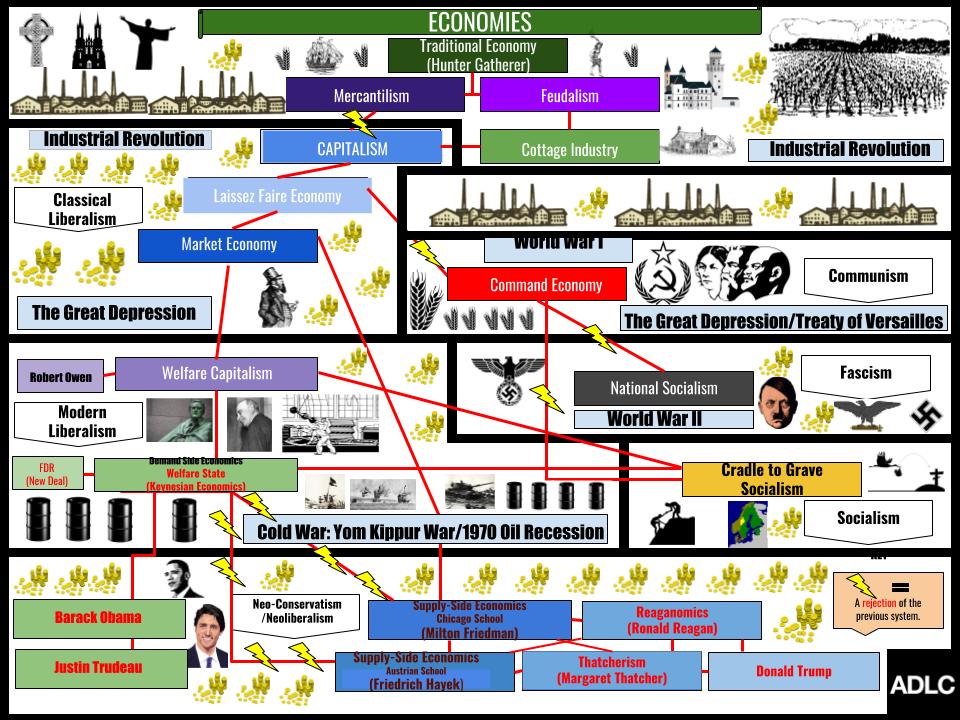
26. UNIT 4 SUMMARY
Unit Four has explored:
- resistance to liberalism historically through the development of communism and fascism
- examined the conflict between ideologies between the end of World War Two and the fall of the Soviet Union
- some examples of resistance to liberalism today through a focus on the issue question
To what extent is resistance to liberalism justified?
Through this study you should now be closer to having your own ideas about why people and their government resist liberal principles and if reasonable for them to do so.
| Nazi Germany | Communist Soviet Union | Conflicting Ideologies and International Relations | Contemporary Resistance to Liberalism |
|
|
|
|
27. SUMMATIVE EXAM 2
Please review all of your notes, readings, and vocabulary you have
learned up until this point. Once you feel you are ready, you can
attempt your second summative exam of the course. You will need
permission to write this exam and you will need to be supervised at your
school or campus.
Please let me know if you have any questions!


